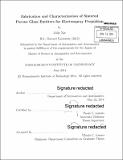| dc.contributor.advisor | Paulo C. Lozano. | en_US |
| dc.contributor.author | Xie, Julie | en_US |
| dc.contributor.other | Massachusetts Institute of Technology. Department of Aeronautics and Astronautics. | en_US |
| dc.date.accessioned | 2014-10-08T15:30:32Z | |
| dc.date.available | 2014-10-08T15:30:32Z | |
| dc.date.copyright | 2014 | en_US |
| dc.date.issued | 2014 | en_US |
| dc.identifier.uri | http://hdl.handle.net/1721.1/90809 | |
| dc.description | Thesis: S.M., Massachusetts Institute of Technology, Department of Aeronautics and Astronautics, 2014. | en_US |
| dc.description | Cataloged from PDF version of thesis. | en_US |
| dc.description | Includes bibliographical references (pages 81-83). | en_US |
| dc.description.abstract | Ionic electrospray thrusters are promising candidates for CubeSat propulsion systems in space, due to their low power requirement and small form factor. Current technology has demonstrated thrust levels of 10 - 40[mu]N, enabling station keeping and attitude adjustment maneuvers. Densification of emitter arrays could increase the thrust density and potentially expand the application space for electrospray propulsion, but current fabrication processes have intrinsic densification limits. A novel, alternative fabrication process to produce microstructure emitter arrays additively by molding is presented in this paper to enable studies into densification as well as wafer-level processing. MEMS techniques are used to process a silicon-on-insulator wafer to produce molds. Soda-lime glass microspheres with a median diameter of about 4[mu]m are then deposited into these molds and sintered to form porous columns with a diameter of 25[mu]mt, 50[mu]rm, or 75[mu]m. These columns become emitters when the device layer is etched with XeF₂. A porous sintered glass piece is tested as an emitter to characterize the suitability of the mateiral for electrospray propulsion, and an emitted current of 6[mu]A was measured when a voltage of 2.5kV was applied. Currents from 0.1 - 10[mu]A per emitter tip have been observed from established metallic porous emitters; this demonstrates that the sintered glass emitters are a competitive candidate for electrospray propulsion. | en_US |
| dc.description.statementofresponsibility | by Julie Xie. | en_US |
| dc.format.extent | 83 pages | en_US |
| dc.language.iso | eng | en_US |
| dc.publisher | Massachusetts Institute of Technology | en_US |
| dc.rights | M.I.T. theses are protected by copyright. They may be viewed from this source for any purpose, but reproduction or distribution in any format is prohibited without written permission. See provided URL for inquiries about permission. | en_US |
| dc.rights.uri | http://dspace.mit.edu/handle/1721.1/7582 | en_US |
| dc.subject | Aeronautics and Astronautics. | en_US |
| dc.title | Fabrication and characterization of sintered porous glass emitters for electrospray propulsion | en_US |
| dc.type | Thesis | en_US |
| dc.description.degree | S.M. | en_US |
| dc.contributor.department | Massachusetts Institute of Technology. Department of Aeronautics and Astronautics | |
| dc.identifier.oclc | 891650820 | en_US |
